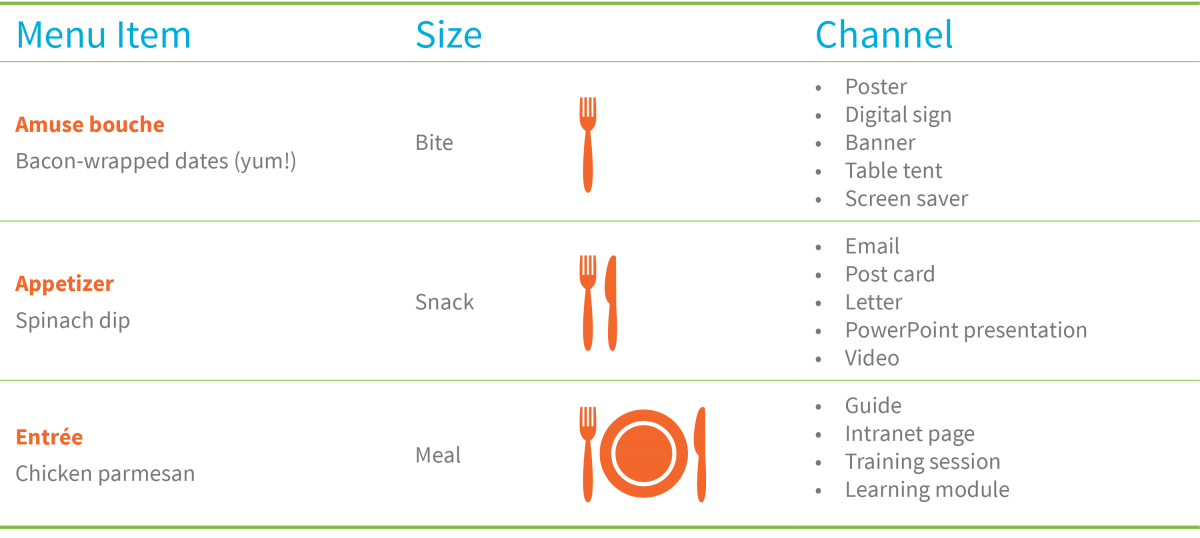
Employees are overloaded with information. They check their email 30 times an hour. Their attention span is decreasing. And they are constantly in meetings and are often multitasking.
You can break through with compelling content employees can use. That’s why it’s time to focus your efforts on cooking up communication that satisfies employees’ cravings.
Here are seven tips to help you do just that.
1. Provide a well-balanced menu
Communication comes in different sizes, so why not give employees options. Employees may want a bite (quick take), a snack (a little more substance) or a full meal (all the details) to satisfy their hunger for a topic. That’s why a well-balanced menu of communication is important.
Most employees are looking for bite- and snack-sized communication. But a full meal is crucial during times of change as it’s an important employee engagement tool. For example, when there are lots of benefits changes or you’re updating the way you do performance management, employees will hunger for details.
During your next communication campaign, identify channels from the table below to make sure you’re serving up a little bit for everyone.

2. Organize your tools
Your communication channels are just like a chef’s cooking utensils. Every tool — from the simplest to the most sophisticated — serves a purpose. That’s why it’s important to have a system that defines the role of each channel.
To properly articulate your channels, answer the following questions for each:
- Objectives: What is this channel trying to achieve?
- Standards: What are the best practices for this channel?
- Key content: Should this channel highlight key messages or provide all the details?
- Frequency: Is this channel used weekly or only when needed?
- Process: How does this channel work? How does it work with other channels?
- Audience(s): Who should this channel target?
Capture the results to maintain consistency and determine how content will be served to employees.
3. Keep content fresh
Improve the quality of your content by establishing consistent standards. These standards, such as intranet guidelines, email templates and town hall meeting formats, aren’t intended to impose rigid rules. Instead, they set expectations for how communication should occur across your organization. Plus, standards can make your job easier while increasing the value of communication.
For a quick reference, create a chart with each of your channels and include:
- Standards for the copy
- What “best” looks like
- Potential downsides
- Examples
You can even develop templates to maintain a consistent design look and feel.
4. Create a rich, zesty copy
If your copy stinks, no one will want to consume it. That’s why your core content strategy should be to create succinct, boiled-down messages.
Here are some easy ways to make messages to employees more engaging:
- Keep it short: Use appropriate portions to ensure your communication can break through.
- Bite-sized: 25 words max
- Snack-sized: 150 to 200 words
- Meal-sized: 800 words max
- Use compelling images: Keep readers interested by adding compelling visuals, such as an intriguing photo, a simple chart or an infographic.
- Break it down: Chunk information into smaller bites to make it easier to read. Make keywords bold, use bulleted lists and descriptive headlines.
- Verbify it: Create action-oriented headlines and subject lines. If the only thing an employee reads is the headline, he or she should still understand what he or she needs to do.
5. Try something unexpected
Getting outside your comfort zone can have a big impact. Whether it’s simply a new channel — like video — or something completely out of the box — like an airplane banner — something new and different will get employees’ attention.
To brainstorm what you can do that’s new, facilitate an idea session:
- Get together a group of key stakeholders and provide Post-it® Notes and markers to each attendee (use scented markers for a fun twist).
- Ask the group, “If budget and time weren’t restrictions, how could we make an impact with communication?”
- Give the group a few minutes to individually write down answers. Then have each person share, putting like items together.
You’ll quickly gather some great out-of-the-box ideas.
6. Master the craft
Just like cooking, crafting content is a skill that needs to be honed. This four-step process will help you sharpen your skills:
- Step 1: Explore what you know about the topic
This step is the discovery process. Think about past work you’ve done that relates to your topic. Have you created anything similar in the past? How should it be similar or different? Are there key messages or initiatives that your topic should be tied to?
- Step 2: Sketch it out
Gather ideas or content that inspires you. Draft a quick outline or sketch a storyboard to bring your content to life. Think about how you can support your copy with visual elements, such as sidebars, callouts, photos or videos. Get feedback from subject matter experts on how to build the visual elements.
- Step 3: Draft it
Write down as much copy as you can, using your outline or storyboard as a guide. Walk away from the copy for a day, then come back to fine tune it. Share your draft with a colleague to get feedback.
- Step 4: Build it
Once you have a near-final version of the copy, work with available tools to build visual elements. Whenever possible, get help from a designer or IT expert to add special visual interest or fun features.
7. Develop a healthy communication habit
Just as a chef occasionally refers to his or her cookbook, you should use your annual communication plan as a guide to keep you on track. Whether you’re reviewing key messages, checking timelines or assessing strategies, it’s important to keep your communication plan top of mind. It will help you create content that is consistent and targeted.
Here are three ways to build communication plan reminders into your routine:
- Add appointments to your calendar to check in on your communication plan objectives throughout the year. This will help you set aside time on a regular basis.
- Meet quarterly with your team to discuss feedback and make changes. Your communication plan may need to be adjusted to meet your objectives.
- Create a placemat-sized plan to keep on your wall as a constant reminder. You can check off tactics as they are completed or write important notes.
Orginially published on medium.com




